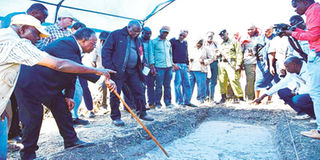New discovery raises Tz’s profile

Prof Masao, (in yellow cap) briefs Prof.Jumanne Maghembe (holding a stick) at the Laetoli site on July 8, 2016. PHOTOI ELISHA MAYALLAH.
What you need to know:
Other officials present included Tanzania National Environment Management Council DG, Eng Bonaventure Baya, who is also the Chair of the national technical advisory committee on the development of museum for Laetoli project, and the Director from the Antiquities’ division in the ministry of natural resources and tourism, Mr Donatius Kamamba.
Together with journalists from other media houses from Tanzania and abroad, we arrived at Laetoli site in Ngorongoro Conservation Area, north of Tanzania on Friday morning last week.
We were here to witness the official announcement to the world about the second important discovery of human evolution evidence at Laetoli.
By all accounts, Laetoli holds the record of the world-famous archaeological site where the first hominid footprints excavations were discovered by a team of scientists led by Dr Mary Leakey in 1978. This geological site has over the years inspired scientists, researchers and geologists including tourists to witness human evolution evidence in Africa.
Prof Jumanne Maghembe, minister of natural resources and tourism, the guest of honour arrived shortly after with the Ngorongoro CEO, Dr. Freddy Manongi to grace the event.
Other officials present included Tanzania National Environment Management Council DG, Eng Bonaventure Baya, who is also the Chair of the national technical advisory committee on the development of museum for Laetoli project, and the Director from the Antiquities’ division in the ministry of natural resources and tourism, Mr Donatius Kamamba.
We were walked by Prof Fidelis Masao, a researcher and senior lecturer at the University of Dar es Salaam, Prof Charles Musiba, a Tanzanian archaeologist based in the US in the company of other International geologists who have been working at the site.
Unhindered view of the expansive landscape stretching far, its sheer size in a rolling, open setting and relatively dry land took us through the stretched valley floor surrounded by scrubby habitat, sheer cliffs on either side, to find the three different sites.
The walk through sites within a trackway aroused intertwined feelings of wonder and mystery as Prof Masao and Prof Musiba, poured detailed briefs of the excavation findings.
Prof Fidelis Masao and Dr Elgidius Ichumbaki from the University of Dar es salaam were contracted to perform the cultural heritage impact assessment by the site contractors, Peter Rich Architects from South Africa in partnership with GMP Consulting Engineers of Arusha.
During their assessment work they were joined by other locals Mr Josephat Gurtu, Mr Augustine Sungito, Mr. Eliya Bura and Mzee Simoni Mataro, where they discovered the hnofossil record that reputedly consisted of hominin footprints.
the footprints were impressed on a fine-grained volcanic ash and constitute some of the world’s strongest evidence regarding the origin of human ability to walk upright bipedaly. And animal trackways and raindrop imprints are also well-preserved in the same location. All these are important landmarks of palaeanthropology.
The second major discovery is in several trails of footprints, located in one trackway, dated 3.7 million years’ old of hominin footprints, about 60 metres from the first discovery of Dr Leakey in 1978.
The latest discovery, according to Engineer Joshua Mwankunda from the NCAA, is a result of a scientific research work in which the NCA gathered a team of scientists from all over the world at Laetoli. The team of geologists led by Tanzania researchers verified the validity of the print as homin footprints in their ten-day research work at Laetoli.
Engineer Mwankunda is the national project manager at the site, who has seen consistent research work at the site. He has been a manager for eight years at NCAA in charge of the heritage and cultural department. He has since spent the recent three years at the site to coordinate activities.
It took nearly two hours to fathom the discovery as most of the people in the entourage keenly watched as experts showed the minister the varied footprints in different shaded areas whose importance is insurmountable.
In his speech to announce the new discovery to the world, Prof Maghembe applauded the good work that was done by scientists, consultants, geologists led by Tanzanian researchers. He said the ongoing work in the several trails should continue at a good speed.
He sais the new discovery, places Tanzania at the fore front in human origin research particularly in understanding the origin of upright posture and bipedal gait by providing the only concrete evidence that our ancestors were fully bipedal 3.7 million years ago.
And by this new discovery the NCA profile is raised once again, and the prints provide a unique opportunity as a tourist attraction for local and International visitors.
We drove out of the Laetoli passing through wildlife roaming in the savannah landscape.




